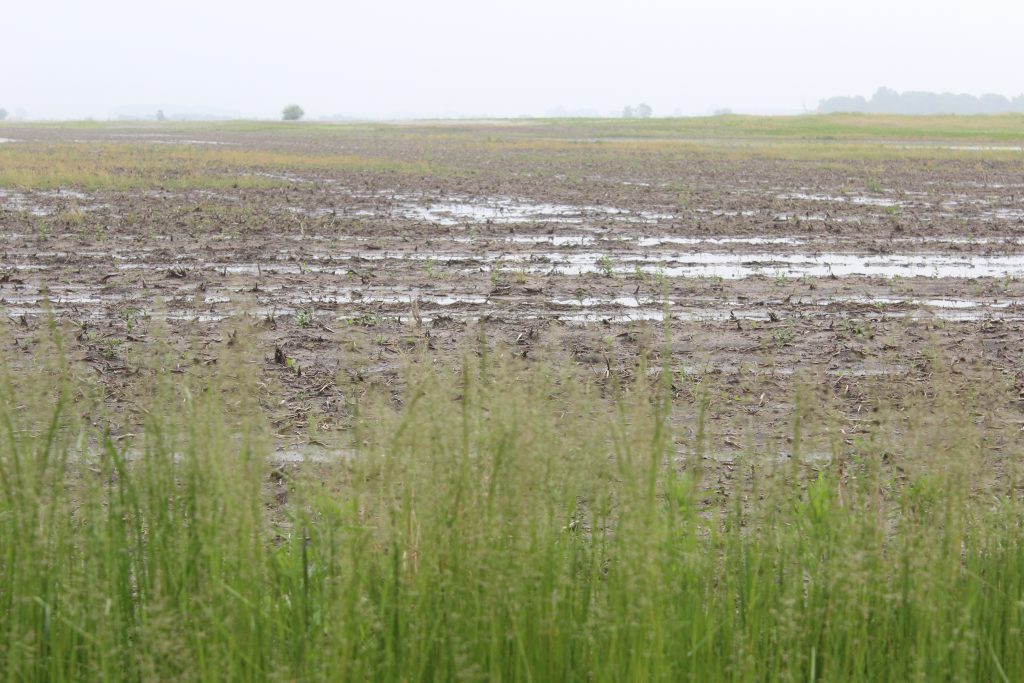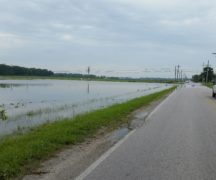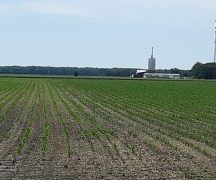By JAN LARSON McLAUGHLIN
BG Independent News
Jim Bostdorff keeps his eyes on the weather radar – hoping for a dry spell that will allow him to get some crops in the ground.
“I’ve been farming 65 years,” said Bostdorff, who farms with his son in Middleton, Washington, Center and Plain townships surrounding Bowling Green. “I’ve never seen it this wet, this late, this long.”
Local fields are normally full of tractors this time of year. But the vast majority of farm acreage in Wood County has not been touched yet this year.
Meanwhile valuable time is ticking away.
“We have nothing done,” said Dave Bruning, who farms in Freedom Township near Pemberville. Bruning is trying to stay calm – “but as soon as the calendar changes over to June,” any sense of calm will likely disappear, he said.
Wood County farmers are not alone.
The USDA released its Crop Progress Report on Tuesday – showing the slowest corn planting in U.S. history. In Ohio and Indiana, just 22 percent of the crop was planted. South Dakota sits at 25 percent, Michigan at 30 percent, and Illinois at 35 percent.
April showers turned into May downpours …..
Jim Cajka, who farms land in Webster and Troy townships, has stopped adding up the rain that has fallen on his fields this spring.
“I lost track,” he said.
But over at the Bowling Green Wastewater Treatment Plant, the rainfalls are recorded daily. In April, the plant saw 5.12 inches of rain, and as of Tuesday this week, May had brought 4.38 inches of rain.
“Oh yeah, it’s definitely a wetter spring,” said Gary Krukemyer, at the plant. “I grew up on a farm and I haven’t seen when farmers haven’t been able to plant by now.”
Alan Sundermeier, OSU extension agent in Wood County, said the rain this spring is unprecedented.
“It’s a pretty desperate situation for farmers,” he said. “This breaks all records since they started recording.”
It’s not just the amount of rain that is a problem – but also the consistency of the wet weather, Sundermeier said. The frequency has left no drying out period in between showers that would normally allow farmers to at least spray their fields.
“It’s kind of depressing,” Bostdorff said about his frequent weather checks.
What’s at stake?
The later crops are planted, the greater the risk that a fall frost could kill them before they have time to mature.
Paul Herringshaw, who farms with his son in Liberty, Milton and Plain townships, referred to the decisions made by farmers in this unpredictable weather as a “crapshoot.” Then he decided it was riskier than that.
“It’s like a high stakes poker game,” Herringshaw said.
Making it worse is that many farmers couldn’t do a lot of their fall field preparations last year due to weather problems.
“That’s the hardest part,” Cajka said. “We didn’t get anything done last fall. We were lucky just to get the crops out.”
The winter wheat is suffering.
“We’re getting close to losing a few fields of wheat,” Bostdorff said.
Corn should already be in the fields, and soybeans should follow anytime now. But even with ideal weather conditions – a halt in the rain, lots of sunshine, and some wind – it will be weeks till the fields will hold today’s farm equipment.
“We’re not even close to planting,” Cajka said. “Top end yields are not achievable now.”
No-till fields can’t be sprayed. “The weeds are just growing,” he said.
Bostdorff was able to spray some fields – but only because he went to the extra expense of hiring a plane to spray.
“The only thing we have done is hire a plane to put fertilizer on the wheat,” he said. “It’s so wet, we can’t get out in the field.”
Corn is traditionally planted by the latter part of April, Bostdorff said. Planting later is taking a chance.
“You’re playing the odds,” he said. “Corn goes by days of growth.”
So some farmers will likely switch to a corn with a shorter growing season. But if too many need to make that switch, they may find a shortage in that seed.
“If the seed is available,” Sundermeier said. “I expect a lot of corn won’t be planted this year.”
Some farmers may switch to soybeans in fields where they had planned to put corn. Soybean planting is normally winding down by Memorial Day, but healthy crops of the more durable beans have been harvested if planted later.
But Kent Schuerman, a crop insurance agent in the Pemberville area, cautioned that the prospect for yields could go down dramatically for soybeans planted in the last half of June.
“It’s the game we play,” he said, voicing concern for fellow farmers..
Dave Housholder, who farms in Portage, Center and Freedom townships, said many farmers may be eyeing the options of reducing their corn acreage, using a shorter season corn, or only planting it in their dryer fields.
Even the old-timers ….
With more than six decades of experience in the fields, Bostdorff has noticed a change in the planting seasons.
“Our seasons are screwy. We have no spring anymore,” he said, noting the weather seems to go straight from cool and wet to the steamy hot of summer. “I don’t like it.”
And nearly every crop is affected.
“The hay crop is really hurting,” Cajka said. “The old-timers have said they haven’t seen it this bad.”
Herringshaw and his son tried to get into a field on high ground last weekend.
“We got rained out,” he said. “I’ve never seen it this wet. We haven’t turned a wheel.”
Housholder has also noticed the change in climate. It used to be that farmers could just drive their equipment around the wet spots – but entire fields are now wet. “The planting season keeps getting shorter.”
“This is like nothing I’ve seen in my career,” said Housholder who has been farming since 1976.
Farmers tend to have good memories for which years the weather hurt their harvests.
Bruning recalled 1989, when he couldn’t get in the field to plant until June 11. The beans were in by the end of June – but an early frost did in the crop.
Cajka remembered 1989 as well. And he recalled his dilemma of whether he should finish planting his soybeans or go to the German festival in Pemberville. The polka music, bratwursts and beer won out, he said, and he finished planting soon after.

Itching to get in the fields …
Some farmers, who have been plotting out their crops all winter, aren’t known for patience. But planting before the fields dry would be a big mistake, local farmers said.
“Putting crops in the mud doesn’t work well,” Cajka said.
Not only will heavy farm equipment get stuck, but it could also cause long-term damage to the soil, Housholder said.
“You’ve got to look long term,” he said. “You don’t want to cause a lot of long term damage to your land.”
Housholder can point out acreage in the county where impatient farmers have gone into fields when the soil was too wet. The compaction damage lasts for years.
“You’ve got to keep that in mind,” he said. “You can’t get out on clay soils without damaging the soil structure.”
Dry soil is also needed to allow for proper planting of seeds, Sundermeier said. The seed will clump up with mud. Even if the top quarter or half inch of the soil is dry, it’s important that farmers dig further down to test the dirt. Corn is planted two inches deep, and soybeans about 1.5 inches deep.
If a handful of soil is squeezed and forms the shape of a ball, it’s still too wet, Sundermeier said.
“Soybeans are a little more forgiving. Corn is the critical one now,” he said.
What is needed now is less rain, more sunshine and a healthy dose of windy days. But lately, that wind has been coming out of the northeast, meaning it is cooler and not as helpful, Herringshaw said.
“The warmer the ground is, the quicker it will dry out,” he said.
Insurance safety net …
As a crop insurance agent, Schuerman’s phone is crazy busy right now.
“It’s every minute of every day,” starting with the first call from a worried farmer at 7:30 a.m. on Tuesday.
“Not a lot of people have been through something like this,” Schuerman said of the incredibly wet spring. “They are nervous.”
Most farmers know enough to have crop insurance. To get full reimbursement, corn must be insured by June 5, and soybeans by June 20.
“We’re already looking at that,” Herringshaw said.
Those who can afford higher coverage will likely benefit this year.
“I’ll be honest with you. I took higher levels because of the trade war,” Housholder said.
This year, those with more coverage will fare better, Schuerman said.
“At a certain level, guys are OK not planting the corn,” he said. They can return the seed and fertilizer.
But those who couldn’t afford the greater insurance may be taking a risk.
“You can’t predict the rest of the summer weather,” Schuerman said. It’s about taking chances. “If we have good, normal weather during the summer, it may make sense to plant late.” However, if the first frost arrives early, that could be the death of the crop.
“It’s really hard to pinpoint,” Schuerman said.
Who gets hurt?
If a farmer can’t plant because it’s too wet, the implications don’t stop at that farmer’s door.
There are seed dealers who will lose out, and fertilizer sales that won’t be made.
And there are grain elevators who will be shorted. Farmers enter into contracts with businesses like Anderson’s, Countyline Co-op and Poet Energy long before their crop goes into the ground.
“They expect the grain,” Schuerman said.
“And farmers are fully expecting they are going to be productive,” he added.
Young farmers are also more likely to be hit hard by this inability to plant. While older farmers are more likely to have their equipment paid off – younger ones are inclined to be leveraged.
“This is putting a lot of stress on them,” Herringshaw said.
“Us old dogs have had a chance to get our debt loads down,” Housholder said. This type of dilemma could make some young farmers think twice about sticking with the profession, he said.
“My concern is we’re going to shake out some younger farmers,” he said.
Not helping matters are the artificially low prices of crops right now, Housholder said.
“People are struggling to survive out here,” he said. “We’ve had this cloud over the market.”





